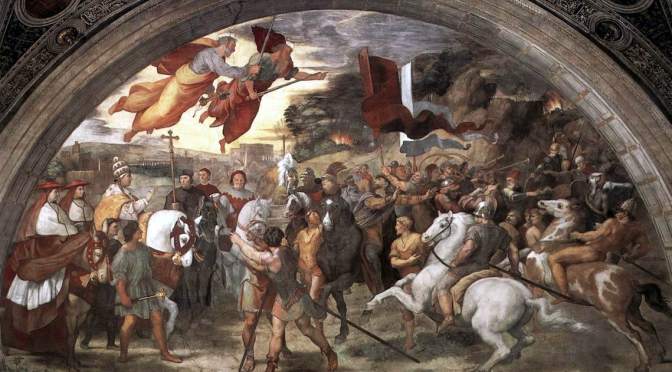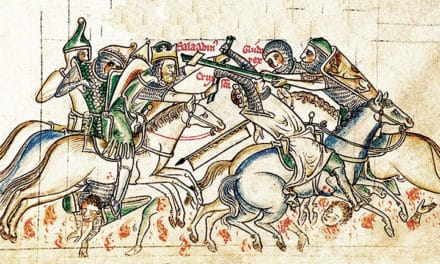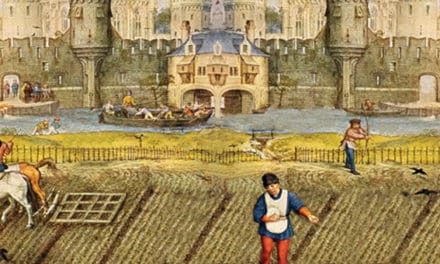The title of this episode is “Barbarians at the Gates – and Everywhere Else”
I live on the coast of Southern California in one of the most beautiful places on the planet – Ventura County. The weather is temperate all year round with an average temperature of 70 degrees. The beaches are pristine and most of the time, uncrowded. The County has several prime surf spots. But every so often, usually during the Winter, storms throw up huge waves that trash the shore. Some of these storms are local and wash down huge piles of debris from the hills that then wash up on the beach. Others are far to the south, off the coast of Mexico but they roll up waves that travel North and erode tons of sand, altering the shoreline.
In the 5th and 6th Centuries, waves of barbarian invasion from the North and East swept across Europe to alter the political and cultural landscape and prime Europe for the Middle Ages.
When Bishop Augustine of Hippo died in 430, the Vandals were laying siege to the city. While the Council of Chalcedon was meeting in 451, Pope Leo negotiated with the Huns to leave Rome unmolested.
European history of the 5th and 6th Cs was dominated by the movement of mostly Germanic peoples into the territory of the old Roman Empire. The subsequent displacement and population shifting had a major impact on Christianity in the West. Medieval civilization was a result of this barbarian upheaval coupled with the vestiges of late Roman society and the impact Augustine had on the theology and practice of the Church.
The incursion of Germanic tribes into the Roman Empire was just the first of 4 massive waves of migration.
The Germans came in the 5th C. The Vars and Slavs swept into the Balkans in the 6th. The Muslims in 7th. And the Vikings in the 8th to 10th Cs.
The resulting societal changes created by these invasive migrations had a monumental effect on the Church. We’ll take a look now at just the first of these population shifts – the Germanic invasions.
The 5th C saw the climax of what was really a long process of mostly controlled immigration by the Germans. They settled land at the Empire’s frontier and served in the military. In truth, while the Romans referred to the Germans as barbarians, they often preserved the Empire by filling gaps in the declining population of Roman lands and by manning the legions. It was the Perfect Storm that saw things figuratively go south for Rome. Factors combining to generate this Perfect Storm were à
1) The Germans were pressed by invaders out of central Asia,
2) Key treaties between the Romans and Germans were broken,
3) The warm weather that had seen a population boom in Northern Europe was followed by bitter cold so that the Germans were forced to move South in search of lands to sustain their larger numbers. It didn’t help Rome that the Germans now knew Roman military tactics and bore Roman arms.
Note to Self: If you don’t want your neighbor to take over your house, don’t give him the keys and alarm code.
Certain dates in the first half of the 5th C are important à
In 410, Alaric, leader of the Western Goths, or Visi-goths, sacked the city of Rome. This was an understandably traumatic event for the Western Empire. His successor, Ataulf, married the Emperor Honorius’ sister.
In 430, Augustine, attempted to explain Rome’s Fall to the Visigoths in his classic work The City of God. He died the year before the Council of Ephesus and the fall of his city, Hippo in N Africa to the Vandals.
In 451, Attila and the Huns from central Asia, swept thru Western Europe, then were defeated by an alliance of Romans and Germans led by Aëtius.
In 455, Aëtius and Emperor Valentinian III were assassinated, and the Vandals under Gaiseric again sacked Rome.
The first contact the Romans had with the Goths came during the reign of the Emperor Decius. During Constantine’s reign they became allies and often entered the Legions at elevated ranks. The Visigoths were being pressured from the East by the Huns, and in 376 sought refuge on the Roman side of the Danube. The emperor Valens granted their request, and there began a mass conversion of the Goths to Arianism. Due to mistreatment by Roman governors, they revolted in 378 and killed the Emperor Valens in the famous Battle of Adrianople. Thus began the real Germanic invasions of the Empire. By 419 The Visigoths had subdued Southern Gaul and all of Spain.
As we’ve noted in previous episodes, when the Goths invaded the Western Empire in the 5th C, for the most part, they came, not as pillaging pagans but as Arian Christians. A Goth Bishop named Theophilus had attended the Council at Nicaea in 325.
The missionary who carried the Gospel to the Goths was Ulfilas in the mid to late 4th C. Ulfilas had amazing success in seeing the Germans won to faith for 2 reasons . . .
1) Their native religion was in decline. Simply put, their gods seemed rather old and shabby.
2) The many German tribes shared a common language.
Realizing translating the Bible into German was a key to successful evangelism, Ulfilas spent considerable time on the project before his death. He left the books of Samuel and Kings out of his translation because he figured the Goths à Well, they already knew enough about warfare.
In 406 when Rome recalled the Legions from the Rhine to protect Italy, another Germanic tribe called the Vandals poured into Gaul, then SW into Spain, and eventually jumped the Strait of Gibraltar to harass North Africa. Their King Gaiseric led them to Carthage which he conquered in 439 and made the capital of an Arian Vandal kingdom. Gaiseric was intolerant of other forms of the faith. In 455 he sent ships across the Mediterranean to sack Rome.
At first, the Donatists in North Africa rejoiced at the coming of the Vandals. Remember they’d been labeled heretics by Rome. But it didn’t take long for them to realize that the enemy of my enemy isn’t always my friend. The Vandals were not friendly. So in 484, a Donatist-Catholic synod met to try and patch up their theological differences.
Catholics were persecuted under some of the Vandal kings in the late 5th and early 6th Cs. It was this persecution that gave the Vandals a bad name far more than any actual acts of “vandalism.” Really, the Vandals were no more barbaric than other Germans.
Justinian’s famous general, Belisarius, repulsed the Vandals and reoccupied North Africa for the Byzantine Empire in 534.
The Visigoths and Vandals were followed up by Suevians, the Burgundians, and the Franks.
The Franks were the least mobile of the Germanic tribes. They settled in northern France and expanded their rule from there. They joined several other German tribes along with the Romans to stave off the common threat of the Huns in 451.
Of all the German tribes, the Franks were the least inclined to heed the work of Christian missions. They seemed immune to conversion until their king Clovis in the mid 5th C.
Clovis’s conversion to the Faith was a significant moment in the history of Europe. Since the Vandals, Goths and Burgundians were Arian, it seemed likely Arianism would take over the West. Alone of the Germanic kingdoms, the Franks under Clovis embraced what we call Catholic or Nicean Christianity, the majority faith of his European subjects.
In 492, Bishop Avitus of Vienna arranged the marriage of a Burgundian princess named Clotilda to Clovis. Clotilda was a committed Christian of Nicean-flavor. The Royal couple had a son, who was baptized but died while still in his baptismal robes. Clovis, who at that point was still a pagan, loudly declared his gods would not allow such a thing to happen. Later they had another son. This one thrived.
Then, in battle with the Alemanni and things not going in his favor, the desperate Clovis asked for the aid of the Christian God. The battle turned in his favor. When the Alemanni were defeated, Clovis submitted to baptism. Bishop Remigius of Rheims performed the rite on Christmas day in 496.
The source for all this is a work by Gregory of Tours titled History of the Franks. This book gave the Franks their identity and shaped their understanding of the future they were to have in forging European history.
Following his baptism, Clovis was anointed in his role as monarch. This anointing of the king by a bishop became a custom among the Franks. The resulting aura of sacred Christian kingship seemed to justify Frankish control of the Church. Sadly, Clovis’s character remained little changed by his official acceptance of Christianity. It seems he adopted the religion as a matter of political expediency, but he didn’t receive the Gospel.
In 493, Odoacer, the German general who’d forced the abdication of the last Western Roman Emperor a little less than 20 years before, was killed by the Eastern or Ostro-goth king Theodoric. Next to Clovis, Theodoric was the most important ruler of the barbarian kingdoms. Theodoric made Ravenna in Italy his capital. He was an Arian who adopted Byzantine culture. Though he was personally tolerant, his Nicean-Catholic subjects weren’t so much. His rule saw the last flowering of late Roman culture in the West. The Ostrogothic kingdom continued until 553, when the Eastern general Belisarius retook much of Italy for the Byzantine Empire.
The cultural revival that occurred during the first half of the 6th C has been called the “Indian Summer of Christian Antiquity.” This period saw a number of influential persons who laid the foundation of Early Medieval society.
Boethius was a from a leading Roman family who became a philosopher and statesman in the court of Theodoric. Although loyal, Boethius came under suspicion and Theodoric had him imprisoned and executed. While in prison, Boethius wrote his most famous work, The Consolation of Philosophy. This work is important because it marks the transition from the Church Fathers or what’s called Patristics to the Scholastics, who we’ll talk more about later. Through his translations, Boethius handed to the Middle Ages, the ethics and logic of Aristotle. The Scholastics regarded Boethius as the greatest authority in philosophy after Aristotle.
Dionysius Exiguus was a Central Asian who came to Rome toward the end of the 5th C. He collected and translated the canons of the Eastern Church into Latin. He also collected the canons and papal decrees of the Western church. His work bore tremendous ecclesiastical authority.
But Dionysius had a much wider significance in that he introduced a system of dating based on the Christian era, beginning with the incarnation of Christ. He’s the one who came up with the whole BC and AD markers to divide time. Until that time, the secular method of charting the date was determined by the rule of the consuls of Rome and the Empire of Diocletian. Unfortunately, Dionysius miscalculated the date of Jesus’ birth, so that according to contemporary reckoning Jesus was born at least 4 BC.
This is also the time of Gregory the Great, who’ll we’ll devote an entire episode to soon.
Last in the chronicle we’ll include in the list of barbarians invasions is the Lombards. In 568 this Germanic tribe broke through the northern bounds of Justinian’s Empire and entered Italy. Gregory the Great turned them back in 593 and secured peace by dividing Italy between Lombard and Imperial land. The Lombards were a factious lot and ruled from 3 centers: The kingdom at Pavia in the north threatened the imperial capital at Ravenna; the duchies of Spoleto and Benevento in central Italy were a danger to Rome and Naples. The Lombards were Arian. Their acceptance of Catholic Christianity did not come until the 7th C.
As we wrap up this episode, let’s take a look at the effect of the Barbarian Invasions.
Augustine wasn’t the only one who attempted a literary response to the Germanic invasions. While the sack of Rome in 410 seemed to many the end of the ages, Orosius, wrote 7 volumes against the Pagans to show that the pre-Christian world suffered no less than the present. The work became a kind of manual for understanding history in the Middle Ages. Orosius gave a central place to the Roman Empire in God’s plan. His history placed on the Western mind the idea of the divine role of Roman civilization. Jerome had already interpreted the 4th kingdom of the book of Daniel as Rome and concluded that it was to continue as long as the Church did. Orosius promoted the view that both the Hebrews and Romans played an important part in the salvation of the world.
Salvian’s work titled On the Divine Government in 440 promoted the historical significance of the Germans. He exaggerated their good characteristics as set over against Roman corruption. He said God used the Germans as the sword of judgment on wicked Rome.
Three attitudes prevailed in Europe regarding the barbarian invasions à
Augustine held that ultimately, political success or failure make no difference. His focus was on the world to come. In contrast, Orosius said Christianity was the guarantor of the Empire’s prosperity. Salvian claimed the Empire was punished for its sins.
But an interesting thing happened once the German invaders settled down in the old Roman lands. By and large, they shed either their Arian-flavored faith for Nicean-Catholic Christianity and they adopted the Roman culture – or at least, what was left of it. Over a couple generations they came to identify themselves as Romans rather than as Goths, Franks, Burgundians and Lombards.
But even with these adaptations to Roman culture, the old Roman and the new Germanic peoples were divided by language. The Romans spoke Latin, the Germans Goth. Customs of food and dress carried on in many places with the Latins wearing togas while the Germans wore trousers. Their legal systems differed and laws were applied to the different classes in the same kingdom. It took centuries for the 2 peoples to blend and become the nations of modern Europe. Greco-Roman civilization was based on cities. The Germanic invasions brought a decline to cities. A rural economy developed in the West, accelerating the move to what we’ve come to associate so centrally with the Middle Ages – Feudalism. While in the East, cities remained the main fixture of the social organization, in the West, landed estates rose to prominence. Rulers relied on their own lands, so there was a decentralization of government.
With a decline in centralized government in the West, the Church took over many of the services once provided by the State, like education. Churches and monasteries were bound to the agricultural economy of the West and profited by a close relationship with local rulers. But one thing that saw the importance and influence of the Church grow substantially at this time was the fracturing that occurred in the political realm. When Western Europe was divided up into hundreds of smaller regions, each with its own ruler, the universal authority of the Church under Rome and the regional bishops provided a continuity that was desperately needed. No secular authority in the West was able to control the Church as an organ of state to the same extent as the Eastern emperors. So in the West, rather than kings ruling in Church affairs, it was the Church that increasingly played an role in political affairs.
Once again I want to say thanks to all those who’ve gone to the CS FB page and given us a like. The comments have been a blessing.
I especially want to say thanks to those who’ve given the podcast a good review on iTunes. iTunes is the main portal for the podcast and positive reviews go a LONG way in helping promote the podcast.
I don’t often mention it, but need to occasionally If you’d like to make a donation to keep Communio Sanctorum online, you can use the donate feature on the website. Sanctorum.us podcast on iTunes.





